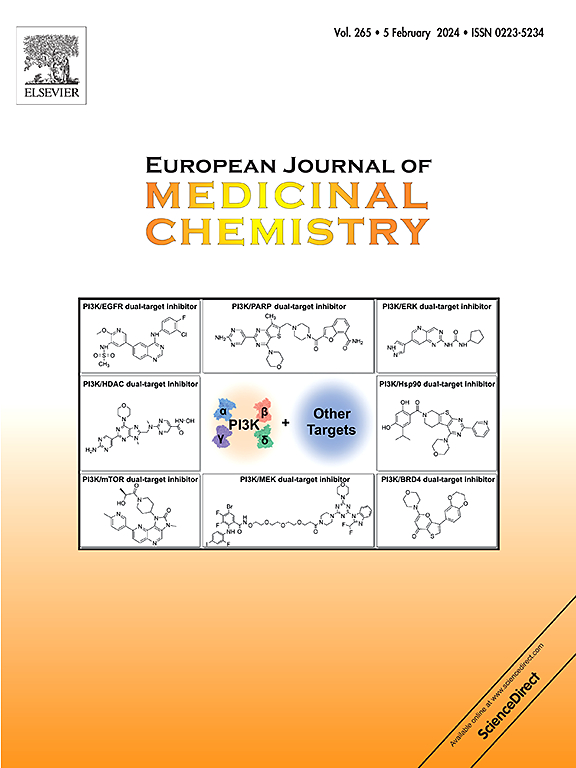Methylenedioxy open-loop and closed-loop aporphines designed for the evaluation of potential antidepressants
IF 6
2区 医学
Q1 CHEMISTRY, MEDICINAL
引用次数: 0
Abstract
A series of methylenedioxy open-loop and closed-loop aporphine derivatives were designed and synthesized to systematically compare their antidepressant effects and addiction potential. The methylenedioxy open-loop derivatives showed slightly superior antidepressant activity compared with their closed-loop counterparts. Notably, the open-loop derivative Ie demonstrated significantly lower addictive potential than the closed-loop derivative IIe, suggesting that the open-loop methylenedioxy moiety may attenuate the addiction liability of related synthetic antidepressants. Further investigations revealed a significant increase in brain 5-hydroxytryptamine (5-HT) levels following treatment with Ie, which may be attributed to its synergistic effect on downregulating the expression of 5-HT2A receptors (5-HT2AR) and serotonin transporters (SERT). Collectively, the results indicate that Ie possesses the most potent and rapid antidepressant activity among the synthesized compounds, outperforming fluoxetine (Flu) in both efficacy and onset of action. These findings suggest that methylenedioxy open-loop aporphines—particularly Ie—hold strong promise as drug candidates for central nervous system modulation.


用于评估潜在抗抑郁药的亚甲二氧基开环和闭环阿菲啡
设计合成了一系列亚甲二氧基开环和闭环阿啡衍生物,系统比较了它们的抗抑郁作用和成瘾性。亚甲二氧基开环衍生物的抗抑郁活性略优于闭环衍生物。值得注意的是,开环衍生物Ie的成瘾性明显低于闭环衍生物IIe,这表明开环亚甲基二氧基部分可能会减轻相关合成抗抑郁药的成瘾倾向。进一步的研究显示,Ie治疗后脑5-羟色胺(5-HT)水平显著增加,这可能是由于其协同作用下调5-HT2A受体(5-HT2AR)和5-羟色胺转运体(SERT)的表达。总的来说,结果表明,在合成的化合物中,Ie具有最有效和最快速的抗抑郁活性,在功效和起效方面都优于氟西汀(Flu)。这些发现表明,亚甲二氧基开环阿啡,特别是ie,作为中枢神经系统调节的候选药物具有很强的前景。
本文章由计算机程序翻译,如有差异,请以英文原文为准。
求助全文
约1分钟内获得全文
求助全文
来源期刊
CiteScore
11.70
自引率
9.00%
发文量
863
审稿时长
29 days
期刊介绍:
The European Journal of Medicinal Chemistry is a global journal that publishes studies on all aspects of medicinal chemistry. It provides a medium for publication of original papers and also welcomes critical review papers.
A typical paper would report on the organic synthesis, characterization and pharmacological evaluation of compounds. Other topics of interest are drug design, QSAR, molecular modeling, drug-receptor interactions, molecular aspects of drug metabolism, prodrug synthesis and drug targeting. The journal expects manuscripts to present the rational for a study, provide insight into the design of compounds or understanding of mechanism, or clarify the targets.

 求助内容:
求助内容: 应助结果提醒方式:
应助结果提醒方式:


